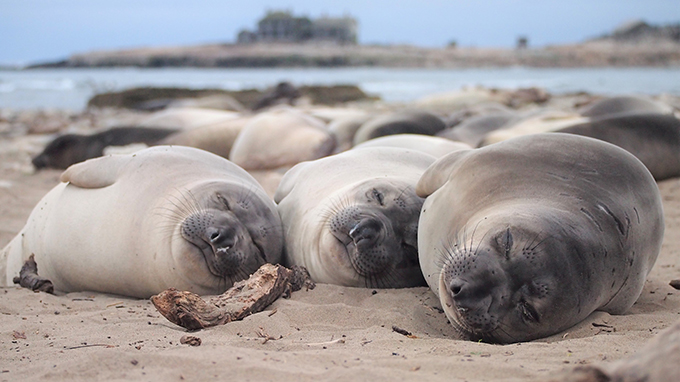This post was originally published on this site
Northern elephant seals are the true masters of the power nap.
On long trips out to sea, the seals snooze less than 20 minutes at a time, researchers report in the April 21 Science. The animals average just two hours of shut-eye per day while swimming offshore for months — rivaling African elephants for the least sleep measured among mammals (SN: 3/1/17).
“It’s important to map these extremes of [sleep behavior] across the animal kingdom to get a better sense of the evolution and the function of sleep for all mammals, including humans,” says Jessica Kendall-Bar, an ecophysiologist at the University of California, San Diego. Knowing how seals catch their z’s could also guide conservation efforts to protect places where they sleep.
Northern elephant seals (Mirounga angustirostris) spend most of the year out in the Pacific Ocean. On these odysseys, the animals forage around the clock for fish, squid and other food to sustain their enormous bodies, which can be as hefty as a car (SN: 2/4/22). Because northern elephant seals are most vulnerable to sharks and killer whales at the surface, they come up for air only a couple minutes at a time between 10- to 30-minute deep dives (SN: 9/28/02).
“People had known that these seals dive almost all the time when they’re out in the ocean, but it wasn’t known if and how they sleep,” says Niels Rattenborg, a neurobiologist at the Max Planck Institute for Biological Intelligence in Seewiesen, Germany, who was not involved in the study.
To find out if the seals sleep while diving, Kendall-Bar and her colleagues developed a watertight EEG cap for the animals. Using the cap and other sensors, the team tracked the brain waves, heart rates and 3-D motion of 13 young female seals, including five at a lab and six hanging out at coastal Año Nuevo State Park north of Santa Cruz, Calif. EEG data recorded while seals were slumbering revealed what the animals’ naptime brain waves looked like.
Kendall-Bar’s team also took two sensor-strapped seals from Año Nuevo and released them at another beach about 60 kilometers south. To swim home, the seals had to cross the deep Monterey Canyon — a locale similar to the deep, predator-fraught waters frequented by seals on months-long foraging trips. Matching the seals’ EEG readings to their diving motions on this journey showed how northern elephant seals sleep on long voyages.
The animals first swim 60 to 100 meters below the surface, then relax into a glide, Kendall-Bar says. As they nod off into slow-wave sleep, the animals keep holding themselves upright for several minutes. But as REM sleep sets in, so does sleep paralysis. The animals flip upside-down and drift in gentle spirals toward the seafloor. Seals can descend hundreds of meters deep during these naps — far below where their predators normally prowl. When the seals wake after five to 10 minutes of sleep, they swim up to the surface. The whole routine takes about 20 minutes.
Looking for that distinct sleep dive motion, the researchers could pick out naps in the dive records of 334 adult seals that had been outfitted with tracking tags from 2004 to 2019. Those sleep patterns revealed that northern elephant seals conk out, on average, around two hours per day while on months-long foraging missions. But the seals sleep nearly 11 hours per day while on land to mate and molt, where they can indulge in long, beachside siestas without worrying about predators.

“What the seals are doing might be something like what we do when we sleep in on the weekend, but it’s on a much longer timescale,” Rattenborg says. He and his colleagues have found a similar feast-and-famine style of sleep in great frigate birds, which fly over the ocean (SN: 6/30/16). “Although they can sleep while they’re flying,” he says, “they sleep less than an hour a day for up to a week at a time, and once back on land, they sleep over 12 hours a day.”
Curiously, northern elephant seals’ sleep habits are quite different from how other marine mammals have been seen sleeping in labs. “Many of them … sleep in just half of their brain at a time,” Kendall-Bar says. That half-awake state allows dolphins, fur seals and sea lions to practice constant vigilance, literally sleeping with one eye open.
“I think it’s pretty cool that elephant seals are doing this without [one-sided] sleep,” Kendall-Bar says. “They’re shutting off both halves of their brain completely and leaving themselves vulnerable.” It seems the key to enjoying such deep sleep is sleeping deep in the sea.
